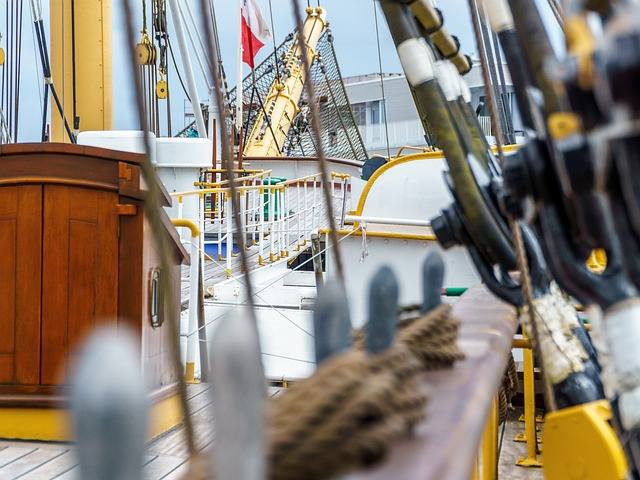Cooking on a tall ship is not an easy task. You have to deal with limited space, equipment, and ingredients, as well as the constant motion of the ship and the changing weather conditions. You also have to cater to the needs and preferences of the crew and the passengers, who may have different dietary requirements or expectations.
Therefore, learning how to cook on a tall ship is vital for anyone who wants to have a comfortable and enjoyable experience at sea.
In this article, we’ll be sharing some tips and tricks for cooking on a tall ship that will help you prepare meals with minimal stress and maximum flavor. We will cover different aspects of cooking in sea conditions, including equipment and tools, ingredients, and techniques.
Equipment and Tools
When it comes to cooking on a tall ship, having the right equipment and tools can make all the difference. Make sure to pack a good set of pots and pans that are sturdy and can withstand the movement of the ship. Make sure that they have lids to avoid losing pressure and moisture.
A cast iron skillet can be particularly useful as it can retain heat well, and it won’t move around as much as other types of pans. You’ll also need a good set of knives, cutting boards, can openers, and spatulas.
Another essential item for cooking on a tall ship is a safety harness. It may sound insignificant, but when the boat is moving and the waves are high, safety is the top priority. So having a safety harness attached to the stove or counter will keep you from falling off and ensure you can cook safely.
Ingredients
The ingredients you use for cooking on a tall ship are just as important as the tools you use. Fresh ingredients are hard to come by at sea, so it’s best to stock up on non-perishable items like canned or dry foods. Pack a variety of grains, beans, and canned vegetables that can be used in different recipes.
When it comes to fresh ingredients, choose options that are hardy and can last a few days without refrigeration. Root vegetables like potatoes, onions, and carrots are great options, as well as lemons, limes, and oranges. They can withstand the movement of the ship and add flavor and freshness to your meals.
Techniques
Cooking on a tall ship requires a slight adjustment in your cooking techniques. The boat’s movement can affect everything from the timing of dishes to the seasoning levels.
To avoid burnt meals, you need to keep an eye on the stove and adjust the heat accordingly. Also, avoid cooking with too much oil or butter as it can easily spill over. When cooking oily or greasy foods, try using parchment paper or foil to create a non-stick surface.
Seasoning is an essential aspect of cooking, but when cooking on a tall ship, you need to be extra careful with it. The ship’s movement can affect the intensity of the flavors, so it’s best to add seasonings gradually and taste as you go.
When it comes to meal planning, it’s best to start with simple dishes that are easy to prepare and can be cooked quickly. Soups, stews, and pasta are great options, as they can be prepared in large quantities and reheated later.
Challenges and Benefits of Cooking on a Tall Ship
Cooking on a tall ship can be challenging for several reasons. Some of these are:
- Limited space. The galley is usually small and cramped, with limited counter space, storage space, appliances, utensils, etc. You may have to share the galley with other cooks or crew members.
- Limited equipment. The galley may not have all the equipment that you are used to in a modern kitchen, such as ovens, microwaves, mixers, blenders, etc. You may have to improvise with what you have or use alternative methods.
- Limited ingredients. The food supplies may not be as fresh, diverse, or abundant as you would like. You may have to rely on canned, dried, frozen, or preserved foods for long periods of time. You may also have to deal with shortages or spoilage due to transportation or storage issues.
- Motion sickness. The constant movement of the ship can cause nausea, dizziness, headaches, etc., especially if you are not used to it. You may have to take medication or use other remedies to prevent or alleviate the symptoms.
However, cooking on a tall ship can also be beneficial for several reasons. Some of these are:
- Adventure. You get to travel to different places and experience different cultures, landscapes, wildlife, etc. You get to see and do things that you may not otherwise have the opportunity to do.
- Learning. You get to learn new skills and knowledge, both in cooking and sailing. You get to experiment with new ingredients, recipes, techniques, etc. You get to improve your problem-solving, communication, teamwork, etc.
- Fun. You get to enjoy the thrill and excitement of sailing, especially if you love the sea and the wind. You get to have fun with your fellow crew members and passengers, who may become your friends or even family.
- Satisfaction. You get to feel proud and fulfilled by your work, especially if you receive positive feedback or appreciation from the crew and the passengers. You get to contribute to the success and well-being of the ship and its mission.
To wrap up
Cooking on a tall ship has its challenges, but armed with the right tools and techniques, you can prepare delicious meals that will keep you and your crew satisfied. Remember to pack non-perishable ingredients, choose hardy fresh produce, and adjust your cooking techniques appropriately.
By following these tips, you’ll be able to cook meals that are not only delicious but also safe and enjoyable. So whether you’re embarking on a long-term sailing adventure or just taking a short day trip, you’ll have all the information you need to prepare meals that will keep everyone happy and full.

![The Best Navigation Tools for Tall Ship Sailing [Ultimate Guide] The Best Navigation Tools for Tall Ship Sailing [Ultimate Guide]](https://www.tallshipssunderland.com/wp-content/uploads/2023/03/navigation-tools-150x150.jpg)


![8 Best Tall Ship Documentaries for History Buffs [Video] 8 Best Tall Ship Documentaries for History Buffs [Video]](https://www.tallshipssunderland.com/wp-content/uploads/2023/03/tall-ship-documentaries-150x150.jpg)
![The Challenges of Living on a Tall Ship [The Ultimate Adventure] The Challenges of Living on a Tall Ship [The Ultimate Adventure]](https://www.tallshipssunderland.com/wp-content/uploads/2023/03/tall-ship-challenges-150x150.jpg)
![How to Train to Become a Tall Ship Sailor [6 Steps] How to Train to Become a Tall Ship Sailor [6 Steps]](https://www.tallshipssunderland.com/wp-content/uploads/2023/03/tall-ship-sailor-150x150.jpg)